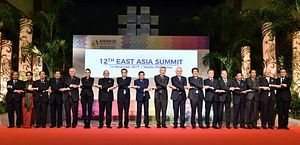A working-level meeting between diplomatic staffers from the United States, India, Japan, and Australia on the sidelines of the Association of Southeast Asian Nations (ASEAN) and East Asia Summits (EAS) has caused quite a lively reaction among Asia-watchers and the policy community. The idea that the Quad (quadrilateral format) is back is exciting at a time when Donald Trump’s administration seems unable to formulate a policy for the Asia-Pacific beyond doing more of what Obama’s team did, minus trade liberalization and plus Twitter-brinksmanship with North Korea.
U.S. Asia policy, already labelled as on “autopilot,” got a first whiff of fresh air at the start of Trump’s Asia tour, when his administration started extensively using “Indo-Pacific” instead of “Asia-Pacific.” The term that includes India into the Pacific balance of power – previously used mostly in Australia – is one that has long asked for more circulation. “Indo-Pacific” supposedly implies that China is not the only resident center of geopolitical gravity in the Western Pacific. The move toward the Quad solidifies that interpretation.
The Quad is about many things, as perfectly surveyed by Ankit Panda, but most importantly about building a rules-based regional order, providing maritime security as a regional public good, and enhancing connectivity, the latter being a more recent trend toward geoeconomics. But what seems to be the elephant in the room is that the Quad is more about containing China than about anything else. For most areas that the four nations see as fertile ground for cooperation, China is seen as a major competitor and rule-breaker. China’s conduct in the South China Sea or the enormity of the Belt and Road Initiative alone are enough to see a crosshair aimed at China behind these themes.
But the implications of quadrilateral coordination really kick in when considering the broader network of partners around it, primarily from Southeast Asian states. The obvious candidates are Singapore, Vietnam, Thailand, and the Philippines. Granted, the latter two are currently in an uncertain position vis-à-vis their U.S. alliance, but a long-term orientation toward balancing Chinese assertiveness is very likely. Vietnam, for example, has long been seeking closer defense relations with Japan and India, since associating with them in terms of security carries less risk of more Chinese pressure. For Southeast Asian nations, the Quad is a chance to balance out China, while at the same time reducing the risks of such a strategy as India, Japan, and especially Australia are very susceptible to Chinese economic pressure if things should go out of hand.
The four-way coordination of regional governance has caused so much interest precisely because it seems like a viable counterweight to a scenario where China’s creeping domination looks almost inevitable. Rules-based orders do not happen by themselves and the Quad, surrounded by something similar to Ash Carter’s “principled security network,” is perhaps the only way to enforce said rules, without subjecting the Pacific to outright U.S.-led policing – no doubt a straight road to more confrontation in the region.
However, as tempting as this Quad-plus format may look, it will mean further deterioration of an ASEAN-centered institutionalized system in Asia. If countries in the region are as enthusiastic about a great power-based plura-lateral format that excludes China, it speaks volumes of how efficient the multilateral institutions that do include China currently are. The Treaty of Amity and Cooperation in Southeast Asia, ASEAN Dialogue Partnerships, ADMM-Plus, and the East Asia Summit have not stopped China from gaining effective control of the maritime and air space over the central part of the South China Sea — at least over the Big Three.
So this is the crux of the matter: Southeast Asian states will certainly want some alignment with the Quad, if such a format is to come to life again. They may look at it as the golden middle between balancing out China and not risking too much pressure on its behalf, since the four-nation grouping is a much softer version of a China-containment strategy than a U.S.-led hub-and-spoke structure. But it will be a soft anti-China arrangement nonetheless, one that may undermine the inclusive and well-structured security architecture presented by ASEAN-centered institutions.
Anton Tsvetov is an expert at the Center for Strategic Research, a Moscow-based think tank. He tweets on Southeast Asian affairs and Russian foreign policy at @antsvetov. The views expressed here are the author’s own and do not reflect those of CSR.
































